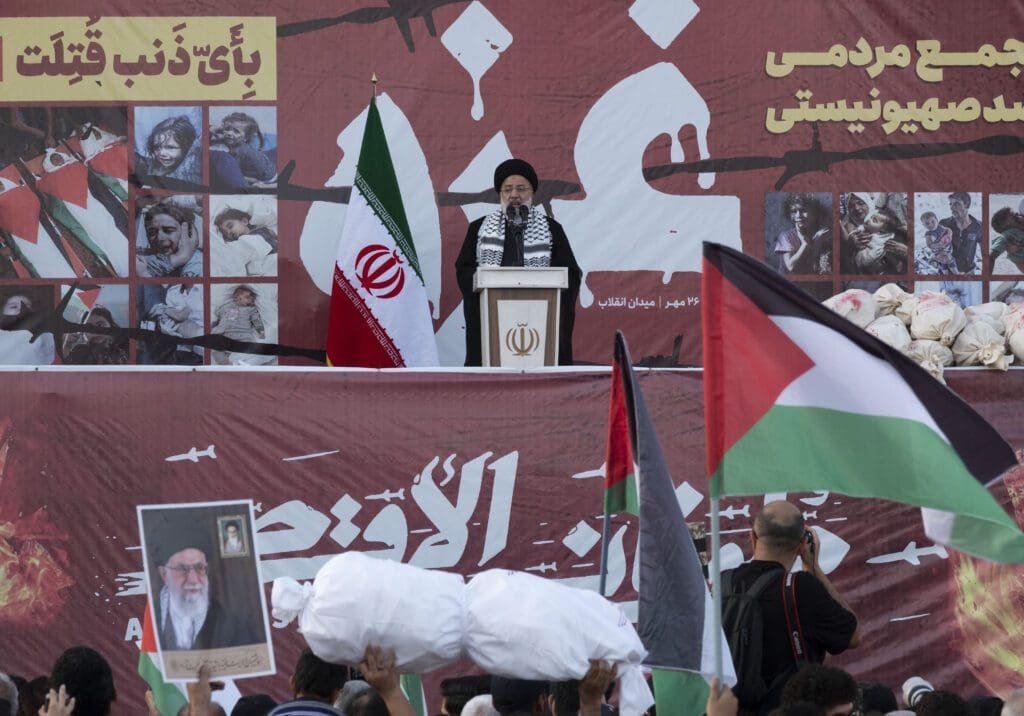The recent drone strike on American soldiers stationed near the Jordan-Syria border, and Washington’s retaliatory strikes in Iraq and Syria, underscore the dangerous potential for a major escalation between the United States and Iran that could engulf the wider region. Washington and Tehran have engaged in a tit-for-tat conflict for several months now, which has seen U.S. personnel or U.S.-aligned actors come under attack either directly or indirectly by Iran, including at least 160 attacks on U.S. forces in Iraq and Syria by Iran-backed militias. Numerous Iranian or Iran-backed militia commanders in Lebanon, Syria and Iraq have also been targeted by the U.S. and Israel, including the most recent assassination of a senior Ketaib Hezbollah commander by a U.S. drone strike in Baghdad.
The risk of a regional conflagration has loomed large since shortly after the October 7 conflict between Israel and Hamas began, with Hezbollah in Lebanon joining the fray on its border with Israel and the U.S. sending naval aircraft carriers to the eastern Mediterranean. That risk escalated dramatically when the Yemen-based Houthis—who have received significant material support from Iran—ramped up attacks on commercial vessels in the Red Sea starting in November. Last month, in a brazen attack, Iran launched a missile strike on Erbil in Iraqi Kurdistan hitting a residential area and killing a prominent businessman and his 11 month-old daughter.
Clearly, the Iranian regime feels emboldened in the midst of the conflict in Gaza. Tehran is reveling in the fact that Western governments and institutions are coming under attack for failing to end the conflict in Gaza, and Iran believes the Biden administration has no appetite for a conflict with Tehran in an election year. With this in mind, Iran sees an opportunity to expand its regional influence by instrumentalizing the war in Gaza, just as it did with marked and bloody impact during the civil wars of Syria, Iraq and Yemen.
Iran is instrumentalizing the regional escalation
It is difficult to imagine that Iran did not play a part in the Hamas attack on October 7, after decades of critical military and financial patronage for the Gaza-based group. At a minimum, its long-standing operational and material support for Hamas makes Tehran complicit in enabling the attack that provoked the latest war, and there are several reasons why Iran would encourage and enable it to happen. This includes disrupting the Saudi Arabia-Israel normalization process that had gained significant momentum in the months leading up to October 7, as well attempting to torpedo the existing normalization agreements between Israel and the UAE, Bahrain and Morocco. The conflict in Gaza has also provided an arena for Iran’s regional proxies to engage militarily against Israel and the U.S. and boost their profile.
Collectively, these attacks have amplified Iran’s projection of power in the Middle East, while conversely testing and undermining Western influence and security posture in the region. Publicly, Iran is positioning itself as a regional power that is acting in defense of the Palestinians as the war in Gaza continues. Accordingly, Iran is portraying its actions as dictated by the war, and thus, based on this posture, the presumption is that it would instruct its proxies to de-escalate current tensions and engage the region in a manner that is conducive to peace and stability once there is an end to the conflict in Gaza.
Yet, in reality, this depiction contradicts the Iranian regime’s overarching regional strategy, which has been in place since its revolution in 1979: to establish a new, hegemonic regional order with the Arabs as subordinates and the U.S. out of the picture. Attacks by Iran and its network of militias on both Western and allied targets—including in Saudi Arabia, the UAE, Iraqi Kurdistan, Syria and Yemen—pre-date the conflict in Gaza. The Houthi disruption of global shipping in the Red Sea, for instance, prompted the formation of a multi-national taskforce that has been patrolling those waters since mid-2022. The recent Erbil assault is not an isolated incident, either. The Iranian regime launched a missile attack on a Kurdish residential area in March of last year, which followed attacks from militias aligned with Iran on residential areas in February 2021. Over several years, these groups have attacked U.S.-led coalition bases across Iraq and Syria as part of a concerted effort to expel U.S. forces from both countries, which has been a key tenet of Tehran’s foreign policy since the clerics came to power more than four decades ago.
Changing Iran’s calculus
For years, the region has lamented Iran’s willingness to fight to the last Iraqi, Syrian and Yemeni as it capitalized on full-fledged conflicts in their respective countries to expand its influence in the wider region. Now, Iran is gambling with Palestinian lives as part of its warped ideological ambitions for the region. It is banking on escalation and another major war to expand its influence further, hoping to enflame the reverberations of the war in Gaza and emerge victorious irrespective of the cost in Palestinian lives and, if necessary, civilians in Yemen, Lebanon and Iraq. Iran’s calculation is that it will suffer limited blowback at home but it is dangerously premised on the notion that Washington and Israel do not have the stomach to directly hold Iran accountable for the atrocities it is enabling through its proxies.
There are several implications of this policy from Iran. For starters, as the recent U.S. strikes on Iranian proxy groups in Iraq and Syria indicate, Iran runs the risk of provoking a stronger Western response that could raise the prospect of a regional war, one that would see Iran suffer significant losses. This includes possible strikes on targets inside Iran itself, which is being increasingly advocated in Washington and other Western capitals. Western decision makers may at some point come to believe that a more intensified military campaign on Iran and its allies would alter the calculus of Iranian decision-makers.
In this respect, although the West has been averse to triggering a major conflict with Iran, Tehran’s regional policies run the risk of turning a war with the West into a self-fulfilling prophecy. Currently, Iran’s general approach to its rivalry with the U.S. has been to let its proxies do its fighting and absorb the retaliation, thereby allowing the regime to reap the benefits and minimize the costs and exposure of direct action. But the prevailing discourse in Western policy circles is that these groups—the Houthis in Yemen, Hezbollah in Lebanon, and the Popular Mobilization Force (PMF) in Iraq—are indistinguishable from the regime in Iran. This, therefore, means that their conduct is likely to be increasingly attributed to Iran.
There is risk of miscalculation from both sides. Achieving de-escalation requires that Iran revise its policies, while the West avoids being drawn into a war with Iran due to a widening campaign against Iranian proxy groups. In practice, this means the U.S. and its allies must find a way of addressing the threat from the Houthis in Yemen or the PMF in Iraq, without necessarily targeting Iran directly and potentially engulfing the region in a full-scale conflict as a consequence. To achieve this, Western governments must clearly articulate what their red lines are so that their actions are not misunderstood or exploited by Iran, and so that the risk of miscalculation on the part of both sides is reduced.
In other words, Western governments must make clear the level of Western fatalities, disruptions to international trade, and provocations from Iran or its proxies it will take before the threshold for a retaliatory strike on Iran is satisfied. This strengthens diplomatic efforts to deter Iran and its proxies, to de-escalate tensions, and to achieve a negotiated settlement.
Most importantly, the current escalation highlights the need for an open line of communication that allows the two sides to avoid misunderstandings that could drag them into a larger conflict. However, it is crucial that this is not exploited by Iran to advance its interests by proxy. For the past decade, Iran has relied on the consistency of Western averseness to open warfare in the region to expand the capabilities of its proxies, both in terms of manpower and resources. These actors have gone on to dominate the domestic political landscape of their respective countries, which has gifted Iran enhanced geopolitical clout and reach. Iran should not have it both ways, able to use diplomatic efforts to forestall a military response to its malign activities while at the same time empowering its proxies in the region to further their collectively malign agenda. Otherwise, the momentum toward regional war cannot be avoided.


